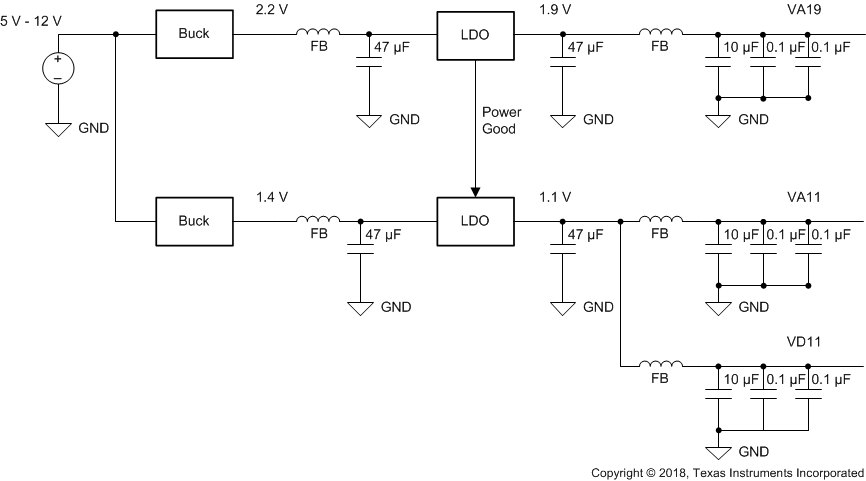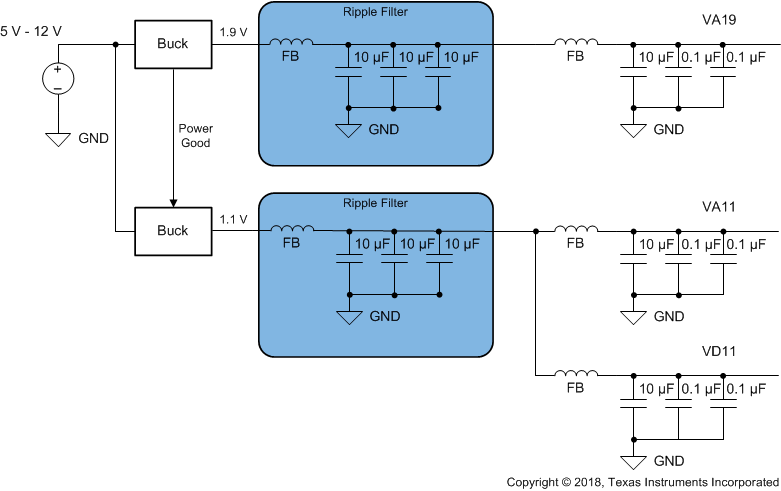JAJSEY1E April 2019 – February 2023 ADC12DJ5200RF
PRODUCTION DATA
- 1 特長
- 2 アプリケーション
- 3 概要
- 4 Revision History
- 5 Pin Configuration and Functions
-
6 Specifications
- 6.1 Absolute Maximum Ratings
- 6.2 ESD Ratings
- 6.3 Recommended Operating Conditions
- 6.4 Thermal Information
- 6.5 Electrical Characteristics: DC Specifications
- 6.6 Electrical Characteristics: Power Consumption
- 6.7 Electrical Characteristics: AC Specifications (Dual-Channel Mode)
- 6.8 Electrical Characteristics: AC Specifications (Single-Channel Mode)
- 6.9 Timing Requirements
- 6.10 Switching Characteristics
- 6.11 Typical Characteristics
-
7 Detailed Description
- 7.1 Overview
- 7.2 Functional Block Diagram
- 7.3
Feature Description
- 7.3.1 Device Comparison
- 7.3.2 Analog Inputs
- 7.3.3 ADC Core
- 7.3.4 Temperature Monitoring Diode
- 7.3.5 Timestamp
- 7.3.6 Clocking
- 7.3.7 Programmable FIR Filter (PFIR)
- 7.3.8 Digital Down Converters (DDC)
- 7.3.9
JESD204C Interface
- 7.3.9.1 Transport Layer
- 7.3.9.2 Scrambler
- 7.3.9.3 Link Layer
- 7.3.9.4 8B/10B Link Layer
- 7.3.9.5
64B/66B Link Layer
- 7.3.9.5.1 64B/66B Encoding
- 7.3.9.5.2 Multiblocks, Extended Multiblocks and the Local Extended Multiblock Clock (LEMC)
- 7.3.9.5.3 Block, Multiblock and Extended Multiblock Alignment using Sync Header
- 7.3.9.5.4 Initial Lane Alignment
- 7.3.9.5.5 Block, Multiblock and Extended Multiblock Alignment Monitoring
- 7.3.9.6 Physical Layer
- 7.3.9.7 JESD204C Enable
- 7.3.9.8 Multi-Device Synchronization and Deterministic Latency
- 7.3.9.9 Operation in Subclass 0 Systems
- 7.3.10 Alarm Monitoring
- 7.4
Device Functional Modes
- 7.4.1 Dual-Channel Mode
- 7.4.2 Single-Channel Mode (DES Mode)
- 7.4.3 Dual-Input Single-Channel Mode (DUAL DES Mode)
- 7.4.4 JESD204C Modes
- 7.4.5 Power-Down Modes
- 7.4.6 Test Modes
- 7.4.7 Calibration Modes and Trimming
- 7.4.8 Offset Calibration
- 7.4.9 Trimming
- 7.5 Programming
- 7.6 SPI Register Map
- 8 Application Information Disclaimer
- 9 Power Supply Recommendations
- 10Layout
- 11Device and Documentation Support
- 12Mechanical, Packaging, and Orderable Information
パッケージ・オプション
メカニカル・データ(パッケージ|ピン)
- ZEG|144
- AAV|144
サーマルパッド・メカニカル・データ
発注情報
9 Power Supply Recommendations
The device requires two different power-supply voltages. 1.9-V DC is required for the VA19 power bus and 1.1-V DC is required for the VA11 and VD11 power buses.
The power-supply voltages must be low noise and provide the needed current to achieve rated device performance.
There are two recommended power supply architectures:
- Step down using high-efficiency switching converters, followed by a second stage of regulation to provide switching noise reduction and improved voltage accuracy.
- Directly step down the final ADC supply voltage using high-efficiency switching converters. This approach provides the best efficiency, but care must be taken for switching noise to be minimized to prevent degraded ADC performance.
TI WEBENCH® Power Designer can be used to select and design the individual power supply elements needed: see the WEBENCH® Power Designer
Recommended switching regulators for the first stage include LMS3635-Q1, LMS3655-Q1, TPSM84424 and similar devices.
Recommended low drop-out (LDO), low-noise linear regulators include the TPS7A84, TPS7A83A, TPS7A47 and similar devices.
For the switcher only approach, the ripple filter must be designed to provide sufficient filtering at the switching frequency of the DC-DC converter and harmonics of the switching frequency. Make a note of the switching frequency reported from WEBENCH® and design the EMI filter and capacitor combination to have the notch frequency centered as needed. Each application will have different tolerances for noise on the supply voltage so strict ripple requirements are not provided. Figure 9-1 and Figure 9-2 illustrate the two approaches.

